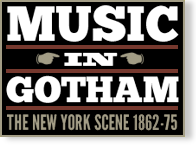Wolfsohn Beethoven Concert Matinee: 10th
Event Information
Venue(s):
Steinway's Rooms
Price: $1
Event Type:
Chamber (includes Solo)
Performance Forces:
Instrumental, Vocal
Record Information
Status:
Published
Last Updated:
27 August 2016
Performance Date(s) and Time(s)
15 Mar 1867, 3:00 PMProgram Details
Performers and/or Works Performed
Citations
After the concert, Wolfsohn and a small circle of friends celebrated the success of the concert series at the new house of the Harmonie Clubs. Wolfsohn is considering offering similar concerts in the next winter season in New York.
Wolfsohn managed to create a popular concert series with these Beethoven matinées. After the intially weak attendance up to the 4th and 5th concerts, the events were always sold out. The concert last night was filled as well with mostly women as usual. Wolfsohn’s delicate, sensitive and nuanced playing gave evidence of his deep understanding of the material again and he received appreciative applause. Friderici (sic) sang with skill and taste.
“Music. Mr. Carl Wolfsohn, having given the last of the Beethoven matinées, is free to indulge the request of so many of his admirers for a Classical Soiree on the largest scale. Such a concert will be given by him on the 6th of April in the large hall of Steinway’s, and will have for the body of its executants the Liederkrans Society and the orchestra of Theodore Thomas, and as the chief features of its programme Chopin’s Polonaise, F sharp minor, and the Choral Fantasia of Beethoven, for piano, chorus and orchestra—a work the power and beauty of which need no commendation. An able rendering of it in every part is certain; and further of the musical event promised us we need not speak. On Friday last, Mr. Wolfsohn classicaly finished a work of devotion to the greatest of classics, undertaken in the face of many disadvantages; and with an honest aim to advance the cause of good music. Madame Frederici, with a warm, genial, but not highly dramatic voice, gave us one of Schubert’s finest songs—‘Gretchen at the Spinning Wheel’—and Mr. Wolfsohn played with special ability the Sonata Characteristique and the Great Sonata. These are two of the most variformed of Beethoven’s piano poems. The sweetness and luster of the former, and the broad energy and difficulty of the latter, one of the problems of executive music, were contrasted with versatile skill by the player.”
“March 15, the tenth and last matinee of the series will take place.”
With the conclusion of Wolfsohn’s Beethoven matinees, he has reached his goal to perform all of Beethoven’s sonatas except for the small opus 49 and 79 as well as the compositions of the master’s 10th year. He has displayed not only earnest efforts and ambition but also talent and recognizable technical and other studies. This asks for many sacrifices and much endurance which is not an easy task. Wolfsohn can clearly say he has done his duty. We assume this must have a soothing effect on him.
Of the three sonatas Wolfsohn played, the first one (F major, opus 10) was the beginning of a style that came to its conclusion in the last (Sonata opus 106). The dramatic mood that is first expressed only timidly (F major), develops into a full climax (op. 106). Op. 106 is also polyphonic. Every voice has its own message, which goes this far, that it is hard too recognize a clear unified theme when only played on a piano. We have heard this sonata played by Liszt, Mortier de Fontaine and Arabella Goddard; but even with Liszt’s performance, we believe the piece would be more effective if other instruments as clarinets and violins in some parts, and in other parts trumpet and drums were used. Especially the last part of the fugue simply does not convey if only on piano. However, this work is in its potential the grandest piece written for a solo-intrument. The first Allegro movement in B major is very powerful in its expression. The Scherzo in B minor is quite melodious. The following Adagio beginning in F-sharp minor is an emotional and stirring outpouring as only Beethoven can write it. A brief Largo is followed by an Allegro part which connects prestissimo to solo Allegro risoluto and the Fugue. The work is technically difficult because the polyphony expects every finger to play independently to convey its separate message. The grand work was written in 1818 in a not very favorable climate. The E flat sonata was written 1811 which was a blessed year despite the financial difficulties in Austria at that time. That year, Beethoven wrote not only the E flat major concerto but also the Egmont overture. The sonata which carries the titles “Les Adieux-L’absence” and “Le retour” was called an “occasional piece” by the critics. Compared with other Beethoven works at that time, it is rather simple; however, it is lively and stimulating and popular with the publishers.

